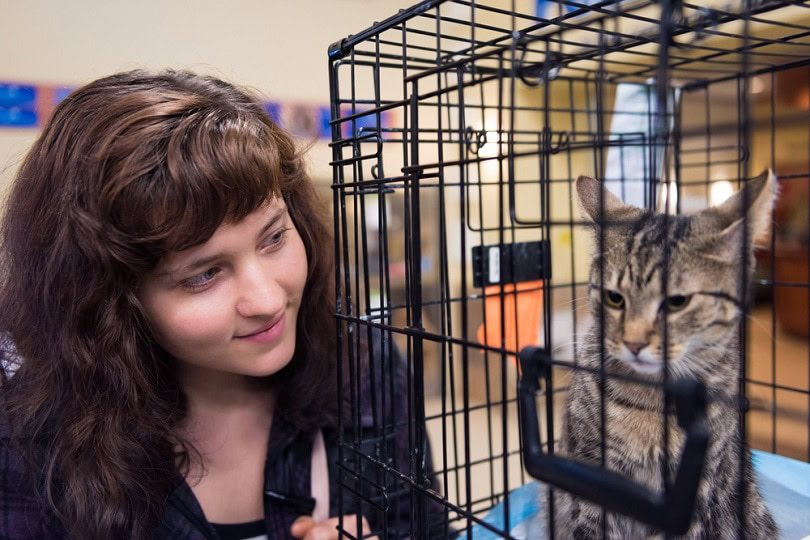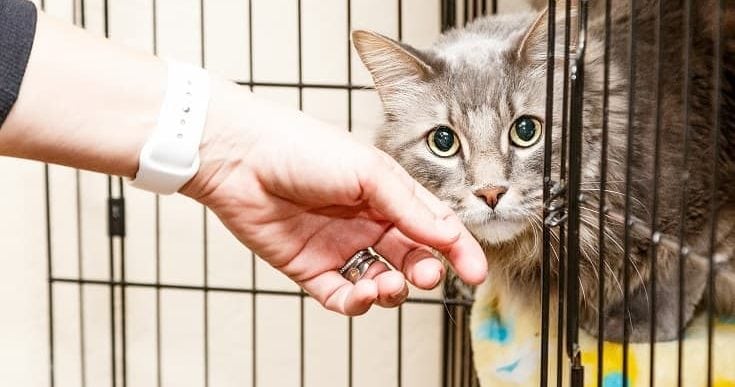VET APPROVED

The information is current and up-to-date in accordance with the latest veterinarian research.
Learn more »Fostering a cat, which means providing a temporary home until they find a forever one, is a wonderful thing to do, but, if you’re a prospective feline foster parent, you may be a bit confused as to where to start. In this guide, we’ll walk you through the best ways to get started in cat fostering and why fostering a cat is such a great idea.

Basic Cat Fostering Requirements
Please note that these are just general requirements and may differ from organization to organization.
- To be over 18 years old.
- A safe, comfortable home.
- A home that permits pets (if you rent).
- Transportation to get your foster to the vet if necessary.
- Committed to day-to-day care (feeding, changing litter, grooming, etc.).
- Able to financially provide for the cat (some organizations cover you for this, others don’t).
- Able to administer medication if necessary.
- Staying in contact with the shelter or foster program leaders.
- Live close to the shelter you’re fostering from (not always a requirement).
- Willing to provide lots of love.
The 4 Steps on How to Foster a Cat
1. Decide if Fostering is for You
First things first. You’ll need to take some time to really think through if fostering is something you’re ready to commit to. Shelters and foster programs may have slightly different requirements for fostering, but all will expect you to be fully able to provide day-to-day care and keep the cat safe.
Fostering isn’t just about feeding and housing a cat for a while, though—you’ll need to provide them with plenty of love and attention. Moreover, some cats have very specific needs or medical issues that you’ll need to invest more time into. If you have a very busy schedule and/or are out of the house a lot, fostering might not be for you.
In addition, while some shelters will cover the costs of the cat’s needs (food, etc.), some don’t. If the latter is the case, be sure you’ll be able to financially provide for the cat.
2. Decide What Kind of Cat You Want to Foster
Cats up for fostering come with a variety of needs. While some are healthy adults, some are tiny kittens without a mother and need to be bottle-fed. Others may be cats that need socialization, have behavioral problems, or have medical conditions requiring special care.
It’s important to think about the kind of situations you do and don’t feel comfortable with so you can communicate this to the fostering program.

3. Reach Out to a Shelter or Organization
When you’re certain fostering is right for you and have thought a bit about what kind of cats you’d be up for fostering, it’s time to reach out to a charity, shelter, humane society, or fostering program in your area.
There are many organizations and shelters out there looking for fosters, so you shouldn’t have much difficulty finding one. Some even provide you with training, so don’t worry if you’ve never parented or fostered a cat before—you can totally still do this!
4. Fill Out the Application
Some organizations will provide you with an application form to fill out when you express interest, whereas others have online forms you can fill in. Fostering application forms typically ask you questions about the kind of cats or kittens you want to foster, your household, other pets, motivation, and more.
Once you’ve been approved, you’re ready to start fostering! You may need to go through some training first, especially if you’ll be looking after cats or kittens with very specific needs. If you have any questions or concerns, don’t hesitate to speak to the organization about them—they’re there to help.


Why Foster a Cat?
First and foremost, fostering can be life-changing for the cat or cats in question. Below are some great reasons to foster a cat.
Fostering Gives More Cats a Chance
Animal shelters are often overcrowded, sometimes to the point where they can’t take in more animals in need until more space becomes available.
By taking a cat out of a shelter and into your home to provide care, you give the shelter a helping hand by freeing up space for more cats that also need a home. This, in turn, increases the number of cats that are successfully adopted and contributes to reducing the risk of pets being abandoned.

Fostering Offers a Much-Needed Transitionary Period
While some cats in shelters are very quickly adopted, others need more time to find their forever homes, either due to special medical or behavioral needs or age. By fostering a cat, you buy the shelter or organization more time to find the perfect cat parent just for them.
Fostering Reduces Stress
Though shelter staff work incredibly hard to do so, it’s not easy to give every cat the full attention they deserve simply because there are so many to care for. Shelters can be very stressful places for animals for various reasons—the new smells, the noises, the limited space, the unfamiliar environment, and so on.
If a cat goes into your home instead, they get the one-on-one care and attention they need, which greatly reduces their stress and contributes to their socialization, thereby making them more “adoptable”.


Final Thoughts
The typical process of fostering a cat involves reaching out to a shelter or rescue organization and filling out an application form. After that, the shelter may give you some training on how to care for the cat or cats while they’re with you. If you’re ready to take the leap into fostering, you’ll be doing cats everywhere a wonderful service.
- https://www.battersea.org.uk/support-us/fostering/fostering-cats
- https://lifelineanimal.org/foster-cats/
- https://www.cats.org.uk/support-us/get-involved-volunteering/foster-a-cat
- https://www.petfinder.com/adopt-or-get-involved/animal-shelters-rescues/fostering/what-is-cat-fostering/#:~:text=How%20do%20I%20sign%20up,foster%20cat%20for%20your%20household
- https://www.dailypaws.com/cats-kittens/cat-adoption/how-to-foster-a-cat
- https://www.aspca.org/blog/seven-reasons-why-fostering-animals-saves-lives
Featured Image Credit: Susan Schmitz, Shutterstock
Contents
- Basic Cat Fostering Requirements
- The 4 Steps on How to Foster a Cat
- 1. Decide if Fostering is for You
- 2. Decide What Kind of Cat You Want to Foster
- 3. Reach Out to a Shelter or Organization
- 4. Fill Out the Application
- Why Foster a Cat?
- Fostering Gives More Cats a Chance
- Fostering Offers a Much-Needed Transitionary Period
- Fostering Reduces Stress
- Final Thoughts











